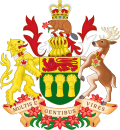Saskatchewan
Saskatchewan (/səˈskætʃəwən, sæ-, -wɒn/ (![]() listen); Canadian French: [saskatʃəwan] sas-CAT-chew-on) is a province in Canada. About 1 million people live in Saskatchewan. Most of its population lives in the southern part of the province. The primary industry in Saskatchewan is agriculture (farming).
listen); Canadian French: [saskatʃəwan] sas-CAT-chew-on) is a province in Canada. About 1 million people live in Saskatchewan. Most of its population lives in the southern part of the province. The primary industry in Saskatchewan is agriculture (farming).
Saskatchewan is known for its wide horizons. The land is very flat in the south, so you can sometimes see far away. Not all the land is flat prairie. There are beautiful scenic woodlands and forests in the central and northern regions and parklands with lakes for fishing. The province is marked by and named after the North and South Saskatchewan rivers that run through it. The province is nicknamed The Land of Living Skies.
History
Saskatchewan was founded on September 1, 1905, the same date that Alberta was founded. The province's colors are gold, red, green, white, brown, yellow, and black. Gold for the wheat, red for the Prairie Lily which is the provincial flower, green for the forests, white for the snow, brown for the fresh cut fields, yellow for the canola and sunflowers, and black for the coal and oil.
Geography
The largest city in Saskatchewan is Saskatoon, followed by the province's capital, Regina. Saskatchewan is (approximately) a quadrilateral (four-sided object) bounded on the west by Alberta, on the north by the Northwest Territories, on the east by Manitoba, and on the south by the American states of Montana and North Dakota.
Saskatchewan Media
Köppen climate types of Saskatchewan
The Battle of Batoche was a battle during the North-West Rebellion.
Farmers at work in 1907. The introduction of Marquis wheat saw wheat output soar in the province.
A memorial stone for Ukrainian Canadians interned during the First World War at the Saskatchewan Railway Museum
An equestrian statue of Elizabeth II in Regina. The statue was unveiled by the Queen in 2005.
Other websites
References
- ↑ "Emblems of Saskatchewan". Government of Saskatchewan. Archived from the original on March 17, 2015. Retrieved July 22, 2014.
- ↑ "Population and dwelling counts, for Canada, provinces and territories, 2016 and 2011 censuses". Statistics Canada. February 2, 2017. Retrieved April 30, 2017.
- ↑ "Population by year of Canada of Canada and territories". Statistics Canada. September 26, 2014. Archived from the original on June 19, 2016. Retrieved September 29, 2018.
- ↑ Saskatchewanian is the prevalent demonym, and is used by the Government of Saskatchewan. According to the Oxford Guide to Canadian English Usage (ISBN 0-19-541619-8; p. 335), Saskatchewaner is also in use.
- ↑ "Gross domestic product, expenditure-based, by province and territory (2015)". Statistics Canada. November 9, 2016. Retrieved January 26, 2017.
- ↑ "Sub-national HDI - Subnational HDI - Global Data Lab". globaldatalab.org. Retrieved 2020-06-18.
- Sasktachwan, More like SusKatchewan










